Abstract
In this paper, we propose using quiver representations as a tool for understanding artificial neural network algorithms. Specifically, we construct these algorithms by utilizing the group algebra of a finite cyclic group as vertices and convolution transformations as maps. We will demonstrate the neural network using convolution operation in the group algebra. The convolution operation in the group algebra that is formed by a finite cyclic group can be seen as a circulant matrix. We will represent a circulant matrix as a map from a cycle permutation matrix to a polynomial function. Using the permutation matrix, we will see some properties of the circulant matrix. Furthermore, we will examine some properties of circulant matrices using representations of finite symmetric groups as permutation matrices. Using the properties, we also examine the properties of moduli spaces formed by the actions of the change of basis group on the set of quiver representations. Through this analysis, we can compute the dimension of the moduli spaces.
1. Introduction
In the modern age, artificial intelligence has seamlessly woven into our daily lives. Whether it is the video assistant referees in football matches or the autonomous cars navigating our city streets, artificial intelligence’s presence is undeniable [1]. At its core, artificial intelligence often relies on the remarkable capabilities of artificial neural networks, a technology that mirrors the workings of the human brain, enabling object recognition, tracking, and much more [2].
The human brain, a marvel of complexity, processes information through the intricate interplay of neurons, transferring signals with astonishing precision. In artificial neural networks, these neurons find their mathematical counterpart as nodes, and the transmission of information takes on the guise of maps. We craft a mathematical model that employs quiver representations to better understand and manipulate these networks. In this model, nodes become vertices, and the transfer of information is akin to connecting paths between them. Quiver representations offer a visual means of grasping the intricate connectivity between artificial neurons, facilitating our exploration of information flows within neural networks.
Crucially, within this framework, the activation function emerges as the arbiter of information significance, determining which data are worthy of propagation through the network. Yet, this is only the beginning of our journey into the captivating world of artificial neural networks.
To further enrich our understanding and empower our analysis, we introduce the concept of Group algebra. It is a mathematical construct formed by mapping a group onto a field—in our case, the complex number set. This addition becomes particularly essential when dealing with situations where a single neuron must process multi-dimensional information, such as colors. Group algebra’s functional properties offer a versatile toolkit for convolution and transformation, allowing us to explore the intricate relationships between different functions within the neural network.
In our exploration, we particularly focus on applying group algebra in the context of cyclic groups, finite groups, with cyclic properties. This choice becomes especially pertinent when creating a quiver group algebra representation, where we draw connections with neural networks. These representations provide us with the means to compare and contrast various artificial neural networks through the lens of morphisms of quiver representations [3,4,5].
As we traverse this intricate web of mathematical constructs, neural science, and data analysis, our journey leads us to the intriguing concept of moduli spaces. These spaces offer a glimpse into the diverse dimensions and possibilities within neural networks, shedding light on their potential and limitations.
In this paper, we will embark on a comprehensive exploration of the interplay between artificial intelligence, quiver representations, group algebras, cyclic groups, and moduli spaces. By the journey’s end, it will become evident that these seemingly disparate threads are tightly woven into a unified tapestry that reshapes the landscape of mathematics, neural science, and data-driven discovery.
2. Quiver Representation from Convolution Group Algebras
2.1. Quiver Representation
Let be a quiver where V is a set of vertices, E is a set of arrows and map every arrow to its source vertex and target vertex , respectively. A quiver can have loops. An arrow is a loop if [4]. Quiver Q is said to be arranged by layers if it satisfies the following conditions:
- All vertices can be arranged in columns from left to right;
- There are no arrows from vertices in the right columns to vertices in the left columns;
- There are no arrows between vertices in the same column [4].
A quiver Q is called a network quiver if it satisfies the following conditions:
- Q is arranged by layers;
- Every input, output, and bias vertex does not have any loop;
- Every hidden vertex has exactly one loop [4].
Now, we will describe a quiver representation.
Definition 1.
Let be a quiver. A quiver representation is defined by a tuple where is a sequence of vector spaces that indices by vertices in V and is a sequence of linear maps that indices by arrows in E, such that for every ϵ, is a linear map [6].
Definition 2.
Let and be two quiver representations of a quiver Q. A morphism of representations is defined by a sequence of linear maps where satisfy
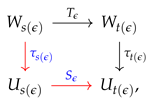 if is a bijection for every , we say that τ is an isomorphism and and are isomorphic to each other [6].
if is a bijection for every , we say that τ is an isomorphism and and are isomorphic to each other [6].

2.2. Convolution Representation
Now, we will see a quiver representation that uses group algebra and a convolution operation that induces linear transformation.
Definition 3.
A non-empty set G, is called a group if there exists a map , that is called an operation of the group, such that
- for all ,
- There is such that for all , called the identity of G;
- For every there is such that .
If there is such that , then G is called a finite group.
Definition 4.
Let G be a finite group. Define
where
- For every and , we have ;
- For every , , and , we have ;
- For every , we define ;
- For every , we define (convolution operation) [7].
Using the group algebra, we will define the Fourier transformation as follows.
Definition 5.
Let and . Let . Define
where . The transformation is called a Fourier transformation [7].
From the definition, the Fourier transformation can be represented by the Fourier matrix
Now, we obtain group algebra with a Fourier transformation and convolution operation. Using the group algebra, we will define a quiver representation that is called a -representation.
Definition 6.
Let be a quiver and G be a finite group. Let be a representation of Q. The representation W is called a -representation if for every where is the group algebra related to G and .
Definition 7.
Let be a -representation of a quiver . The representation W is called a -convolution representation if for every there is such that
We can compare two representations using a transformation called a morphism in quiver representation. The morphism of representations is defined as follows:
Definition 8.
Let be two -representations of a quiver . A morphism of -representations is given by , where is a linear map such that for every , we have
If for every , is invertible then τ is an isomorphism and W is isomorphic to U.
Define as the set of all morphisms of -representations.
Theorem 1.
Let be a quiver. Let be the set of all -representations of Q. Define
where for every , we have
The set Γ under operation · forms a group. Furthermore,
Proof.
It is easy to see that for every , because is invertible for every and commutes with the representations. Next, we will see the associative property of the operation · in . Let . We have
The identity morphism is the identity element in . It is easy to see that every has an inverse because for every , is an isomorphism and commutes with the representations. Therefore forms a group. Now, we will prove that . It is clear that . Let . We know that has an inverse, that is because . We only need to show that is a morphism of -representation. Let W be a -representation and define a -representation
where for every , we have
This means that . Therefore, . □
Now, we will define a -representation that uses convolutions as linear transformations.
Definition 9.
Let be a -representation of a quiver . The representation W is called a convolution representation if for every there is such that
Definition 10.
Let be two convolution representations of a quiver. A morphism of convolution representations is a morphism of -representation. Furthermore, if τ is an isomorphism of -representation, then τ is an isomorphism of convolution representations, and we say W is isomorphic to U.
Let G be a finite group. We write for the set of all convolution representations of a quiver Q and for the set of all isomorphisms of convolution representations of quiver Q. Obviously . Define
If then is isomorphic to as a -vector space. From now on, we assume that G is cyclic. Let and write . Define a linear map
By definition, for all Under the standard basis where if and if , we can write
It means that the matrix representation of a convolution linear map is a circulant matrix. Circulant matrices have a nice property.
Lemma 1.
Let . Let A be matrix, then A is circulant if and only if
Proof.
We know that is the permutation matrix of . So, we can get where is the conjugate transpose of . Let . We know that
We know that A is a circulant matrix if and only if . So, we can conclude if and only if A is a circulant matrix. Because of , we can get if and only if A is a circulant matrix. □
Lemma 2.
Let be two invertible matrices. If is a circulant matrix for every circulant matrix C, then are also circulant.
Proof.
Let be two invertible matrices and . Let be a circulant matrix for every circulant matrix C. We have
where I is the identity matrix. From Equation (1), we have . Now we have
We get . Notice that
Hence is a circulant matrix. From the diagonalization of circulant matrices, we get
where F is a Fourier matrix and D is a diagonal matrix. Now, we have
where . Let and
We get
We know for all because D is invertible. Now, let us see the component of the matrices in the last equation. For column j we get that for every or for . If for every , we must get for but that is impossible because M is an invertible matrix. So, we can get for . It means that M must be a diagonal matrix and . So, we have
Therefore, B is a circulant matrix. Notice that
We conclude that and A is a circulant matrix. □
Let be the set of all invertible circulant matrices over .
Theorem 2.
Let G be a cyclic group of order The set under the operation · forms a subgrup of Γ. Furthermore,
Proof.
Let and . From the definition, we know that in . Let , then for every we have
We know that , so from Lemma 2 we get that must be in too because the inverse of a circulant matrix is a circulant matrix. We have that every must be a circulant matrix, so we have . Now, we will see . We know that the multiplication of two circulant matrices must also become a circulant matrix. So we must have . It is easy to see is a group because forms a group under · operation. □
3. Moduli Space of Neural Networks from Convolution Group Algebras
3.1. Neural Network Function
Definition 11.
Let be a quiver. The delooped quiver is the quiver where , , , and [4].
Definition 12.
Let be a network quiver. The hidden quiver is the quiver where is a set of all vertices in the hidden layer, is a set of all arrows between hidden vertices, induced by [4].
Definition 13.
Let Q be a network quiver. Let be a delooped quiver of Q. A neural network over quiver Q is a pair of such that W is a convolution representation of and where for every we have is a differentiable function. The function is called the activation function [4].
Now, we will define a neural network function using the vertex output function.
Definition 14.
Let be a neural network over quiver Q. Define and a function where
Define the function where every is mapped to with [4].
Using the concept of morphism of quiver representations, we can define a morphism of neural networks.
Definition 15.
Let and be two neural networks over a network quiver Q. A morphism of neural networks is a morphism of convolution representations that satisfies
- for every ;
- For every , we have this commutative diagram:

where is a set of all vertices in the hidden layer. If for every , is bijective, then τ is an isomorphism and is isomorphic to [4].
Now, we will see the similarity of neural network functions from two isomorphic neural networks.
Theorem 3.
If and are two isomorphic -neural networks then
Proof.
Let and be two isomorphic -neural networks. It means that there is an isomorphism such that . Let be an arrow in Q. Let be an input vertex for and . If v is an input vertex, we have
because .
If v is in the first hidden layer, we have
Since is an output vertex, then . Hence, we get
Therefore, we get
For v in the second hidden layer, we have
It means if v is in the second hidden layer, we get
Inductively, we will get for every v in the hidden layer. If v is an output vertex, we have
Therefore, we get
It means for every output vertex v we get
□
3.2. Moduli Spaces of Neural Network
The last theorem tells us two isomorphic neural networks will have the same neural network function. The moduli spaces can be defined by the isomorphic classes of neural networks as follows.
Definition 16.
Let G be a group and X be a set. An action of G on X is a map , denoted by such that
- for every where e is the identity in G,
- for all and all .
The set is called an orbit of the action [8].
We know that is a group of isomorphisms. Let be a set of all -representation of Q. Define a map
where . We know that the map · is an action of on because we have and for all . We also have
for all and all . Now, we can define as the set of all orbits of the action of on . The set is the moduli space of -representations (see also [9]). We will apply the same group action to as a subgroup of and as a subset of . We know that the map · is also a group action of on .
Definition 17.
Let be a network quiver. Define an action of on as . The moduli space of the convolution representation is the set of all orbits from the group action.
Let be a convolution representation of . We can fix a family of vector spaces indexed by and given if v is an output vertex in and for any other vertices in . A choice of convolution representations of hidden quiver and a linear map for each determines a pair where that is known as a framed quiver representation of by the family of vector spaces . From the definition, we can say .
Dually, we can fix a family of vector spaces indexed by and given when v is an input vertex of and for any other . A choices of convolution representation of hidden quiver and a linear map for each determines a pair where , that is known as co-framed quiver representation of by the family of vector spaces . From the definition we can say .
Definition 18.
A double-framed convolution quiver representation is a triple where is a convolution representation of quiver , is a framed quiver representation of , and is a co-framed quiver representation of [4].
Now, we will see the stability of the double-framed moduli space.
Definition 19.
A double-framed quiver representation is stable if
- The subrepresentation that contained in is only zero sub representation;
- The subrepresentation that contains is only [4].
From this definition, we can get this lemma.
Lemma 3.
Let be a double-framed convolution representation. We say is stable if
- For every output vertex v, holds;
- For every input vertex v, holds.
This lemma only gives us a sufficient condition for the stability condition. Not all double-framed convolution representations are stable. Nevertheless, we can see the dimension of the moduli space. Let us see this example first.
Example 1.
Let Q be a network quiver that is drawn like this:
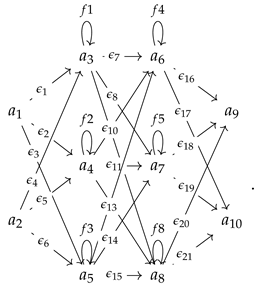 We can make the delooped quiver from Q as
We can make the delooped quiver from Q as
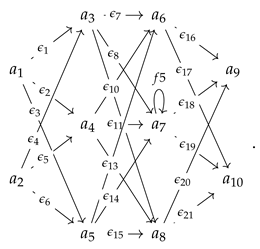 After that, we will make a new quiver as follows:
After that, we will make a new quiver as follows:
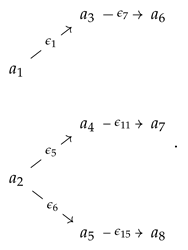 The quiver will be denoted as . The quiver representation of Q is as follows:
The quiver will be denoted as . The quiver representation of Q is as follows:
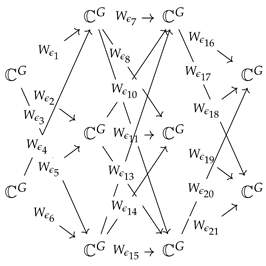 We can also choose a morphism of representation τ such that , , , , , , and such that quiver has weight equal to identity for all arrows:
We can also choose a morphism of representation τ such that , , , , , , and such that quiver has weight equal to identity for all arrows:
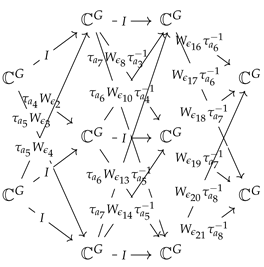





So, we will get that the dimension of double-framed convolution representation is proportioned by the number of arrows that are not equal to identity.
Theorem 4.
Let be the set of input vertices of Q and be the set of output vertices from Q. Define
Let be the set of all orbits from the action of on , then the set will form the moduli space. Furthermore, the dimension of the moduli space is .
Proof.
Let Q be a network quiver with as the hidden quiver and as the delooped quiver. Let W be a convolution representation of quiver . Let . We know that there is such that . We only choose one that for every to build a new quiver . Because of the construction, no two arrows have the same target. This implies that is a union of trees, and the intersection of any two trees can only be a source vertex of Q. Furthermore, for any of those trees, only a vertex that is hidden is a unique source corresponding to that tree. Now, we will construct a morphism of quiver representations . If v is the input vertex, set the . If v is not the input vertex, we have an arrow such that . So, we can set . Using the recursive formula, we can get a new convolution representation of such that every arrow in will be represented as identity linear maps from to . From that fact, we can conclude that the number of free choices of quiver representation will be the same as the number of arrows in that have not been set to identity. Consider
 Using Fourier transformation, we know the dimension of is equal to . Therefore, the dimension of the moduli space is . □
Using Fourier transformation, we know the dimension of is equal to . Therefore, the dimension of the moduli space is . □

4. Conclusions
We have defined a neural network function from an artificial neural network formed by representation, especially for convolution representation. We can also see some moduli space properties formed by the action of the isomorphism group on the set of all convolution representations. From this work, we can minimize the complexity of the neural network algorithm.
In further research, we will explore the moduli spaces from recurrent neural networks and the topology of moduli spaces. We will see some properties of neural network functions with some types of activation functions and their effect on the continuity of neural network functions.
Author Contributions
Conceptualization, L.C.W., I.M.-A. and D.N.; methodology, L.C.W.; software, L.C.W.; validation, I.M.-A. and D.N.; formal analysis, L.C.W., I.M.-A. and D.N.; investigation, L.C.W.; resources, L.C.W.; data curation, L.C.W.; writing—original draft preparation, L.C.W.; writing—review and editing, I.M.-A. and D.N.; visualization, L.C.W.; supervision, L.C.W.; project administration, I.M.-A.; funding acquisition, D.N. All authors have read and agreed to the published version of the manuscript.
Funding
The authors sincerely thank the Institute for Research and Community Services, Bandung Institute of Technology, for the financial support through the Research, Community Service and Innovation Program (PPMI FMIPA scheme) 2023.
Data Availability Statement
No new data were created or analyzed in this study. Data sharing is not applicable to this article.
Acknowledgments
The authors thank the anonymous referees for their helpful comments that improved the quality of the manuscript.
Conflicts of Interest
The authors declare no conflict of interest.
References
- Zhang, Q.; Wang, Y. Construction of composite mode of sports education professional football teaching based on sports video recognition technology. In Proceedings of the 2020 5th International Conference on Mechanical, Control and Computer Engineering (ICMCCE), Harbin, China, 25–27 December 2020; Volume 5, pp. 1889–1893. [Google Scholar]
- Schöller, F.E.T.; Blanke, M.; Plenge-Feidenhans, M.K.; Nalpantidis, L. Vision-based Object Tracking in Marine Environments using Features from Neural Network Detections. IFAC-PapersOnLine 2020, 52, 14517–14523. [Google Scholar] [CrossRef]
- Belov-Kanel, A.; Rowen, L.H.; Vishne, U. Application of Full Quivers of Representations of Algebras, to Polynomial Identities. Commun. Algebra 2011, 39, 4536–4551. [Google Scholar] [CrossRef]
- Armenta, M.; Jodoin, P.-M. The Representation Theory of Neural Networks. Mathematics 2021, 9, 3216. [Google Scholar] [CrossRef]
- Armenta, M.; Judge, T.; Painchaud, N.; Skandarani, Y.; Lemaire, C.; Gibeau Sanchez, G.; Spino, P.; Jodoin, P.-M. Neural Teleportation. Mathematics 2023, 11, 480. [Google Scholar] [CrossRef]
- Assem, I.; Simson, D.; Skowronski, A. Quivers and Algebras. In Elements of the Representation Theory of Associative Algebras; CUP: New York, NY, USA, 2007; Volume 1, pp. 41–96. [Google Scholar]
- Wanditra, L.C.; Muchtadi Alamsyah, I.; Rachmaputri, G. Wave Packet Transform on Finite Abelian Group. Southeast Asian Bull. Math. 2020, 44, 843–857. [Google Scholar]
- Isaacs, I.M. Quivers and Algebras. In Algebra; Graduate Studies in Mathematics; American Mathematical Society: New York, NY, USA, 2009; pp. 42–54. [Google Scholar]
- Armenta, M.; Brüstle, T.; Hassoun, S.; Reineke, M. Double framed moduli spaces of quiver representations. Linear Algebra Its Appl. 2022, 650, 98–131. [Google Scholar] [CrossRef]
Disclaimer/Publisher’s Note: The statements, opinions and data contained in all publications are solely those of the individual author(s) and contributor(s) and not of MDPI and/or the editor(s). MDPI and/or the editor(s) disclaim responsibility for any injury to people or property resulting from any ideas, methods, instructions or products referred to in the content. |
© 2023 by the authors. Licensee MDPI, Basel, Switzerland. This article is an open access article distributed under the terms and conditions of the Creative Commons Attribution (CC BY) license (https://creativecommons.org/licenses/by/4.0/).